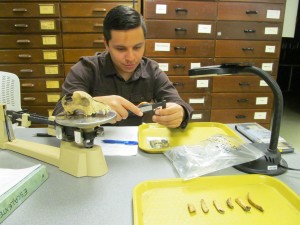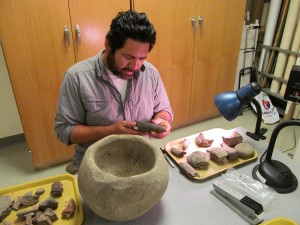Primary Investigators:
Matthew Diez and Alan Leventhal
Anthropology 195 Class
Faculty Sponsors:
Dr. Marco Meniketti and Mr. Alan Leventhal
Background: In 1989 Alan Leventhal in conjunction with student volunteers and members from the Muwekma Ohlone Tribe and Amah Mutsun Tribal Band conducted an archaeological salvage program on a portion of prehistoric site CA-SCL-671, located in northern Morgan Hill at the historic Murphy Springs locality.
After obtaining a negative declaration from an Archaeological/Cultural Resource Management (CRM) firm the developer proceeded to construct a series of single family houses, thus unsuspectingly destroying a major portion of this site. After construction around the spring ceased the developer noticed an array of potential Native American artifacts in backdirt piles and he contacted Alan Leventhal for an assessment. Upon surveying the impacted areas of the site, Leventhal and Ohlone Indian tribal representatives from the two tribes began collecting many groundstone, flaked stone and formed artifacts such as large dart points from disturbed contexts. Based upon the types of archaeological artifacts recovered, the site had the potential of dating back to either Late Archaic and/or Early Bay time period (2000 – 4000 BC) [Which now dates over 8400 years].
Leventhal requested permission to place a series of test excavations within an area that was to set aside as a park and slightly away from the area of impact. Several of the excavation units yielded stratigraphic integrity that included the superposition of mortars and pestles, manos and metates and flaked stone artifacts. Current research conducted as part of Leventhal’s Anthropology 195 class includes the comprehensive analysis of the recovered archaeological assemblage, temporal dating of the identified strata, obsidian sourcing and hydration studies and the writing of a final report co-authored with Matthew Diez.
College of Social Sciences Foundation Research Grant:
In order to accomplish the C14 dating of stratigraphic living surfaces identified at this site, Anthropology Senior, Matthew Diez applied for a grant from the College of Social Sciences Foundation Research and was awarded $1350.00 for his research design. Four charcoal samples were submitted from two excavation units and the AMS dating results are as follows:
Unit 2 – 100-120 cm bs (below surface) – corrected date 1445 BC or 3458 yrs Before Present (BP)
Unit 1 – 120-140 cm bs – corrected date 2211 BC or 4224 BP
Unit 2 – 160-180 cm bs – corrected date 5549 BC or 7562 BP
Unit 1 – 200-220 cm bs – corrected date 6428 BC or 8441 BP
Since graduating in 2013 Matt has been employed with two Cultural Resource Management firms conducting archaeological surveys and excavation at Pacific Legacy and AMEC Environmental and Infrastructure. More recently he has been hired by the Northwest Information Center at Sonoma State University as a GIS Assistant verifying the mapping of archaeological sites through Geo-referencing, Geo-coding, database querying, and digitizatio



